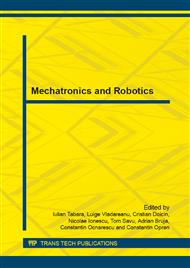p.255
p.261
p.267
p.271
p.277
p.283
p.291
p.299
p.305
Synthetic Representation of the Robotic Assembly
Abstract:
The study of the best conditions to accomplish the robotic assembling imposes the determination of the restrictions imposed by the characteristics of the desired assembling. To analyze the requirements imposed to the assembling robot in this paper there have been considered Petri Graphs with dynamic markings. These schemes allow a synthetic representation of the assembling process and they praise clearly the active phases of the robot.
Info:
Periodical:
Pages:
277-282
Citation:
Online since:
May 2015
Authors:
Keywords:
Price:
Сopyright:
© 2015 Trans Tech Publications Ltd. All Rights Reserved
Share:
Citation:


